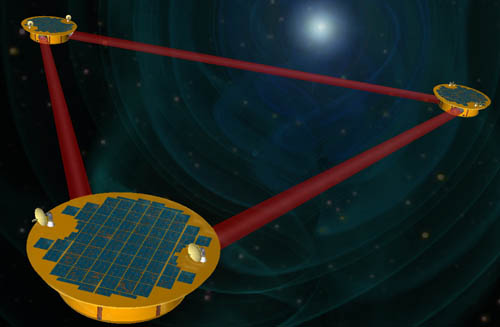SRON and Nikhef receive an ENW-M grant (€500,000) from NWO for the development of the photoreceivers for the gravitational wave detector LISA. It enables them to further develop the existing prototype towards a final version that meets the strict accuracy requirements. They work together with the Dutch companies BRIGHT Photonics and SMART Photonics to produce a photodiode that is large and noiseless enough to pick up LISA’s laser beams of only one nanoWatt.
Astronomers and physicists use gravitational waves to observe events in the Universe that are mostly invisible to our telescopes, such as collisions between stellar black holes or neutron stars. However, ground-based observatories are unable to detect gravitational waves with a length exceeding 10,000 kilometers, meaning that for example supermassive black holes remain invisible. Therefore ESA will launch the Laser Interferometer Space Antenna (LISA) in the mid-2030s, which will use its 2.5 million kilometer arms to detect much longer wavelengths. These arms consist of laser beams between three separate satellites and are able to detect picometer variations in distance.
ENW-M grant
Together, SRON and Nikhef are a candidate to provide the photoreceivers for LISA’s laser beams. In the past few years they have developed a prototype and now receive an ENW-M grant from NWO, with lead applicant Jean in ‘t Zand, to further develop a full-fledged detector for LISA. It should be able to withstand the extreme conditions in space, show a strong reliability and meet LISA’s strict requirements to detect the minuscule vibrations raging through our Solar System.
Strict requirements
After LISA’s laser beams have traveled their 2.5 million km long path, only one nanoWatt of power remains, so the detectors need a low noise level to not drown out the signal. In addition, they must have a diameter of two millimeters to keep the design of LISA’s optics as simple as possible. This is ten to a hundred times larger than usual within photonics applications.
Photodiode
Because of the specific requirements, SRON and Nikhef have to build the photodiode from scratch, together with the Dutch companies BRIGHT Photonics and SMART Photonics. They fabricate a photodiode by growing micrometer-thin layers of the semiconductor indium-gallium-arsenide on a wafer. In order to keep the noise low, the capacitance of the diode must be low, and therefore also the doping level of the semiconductor. The prototype already has the required low noise for diameters up to 1 mm, but improvement is needed for a diameter of 2 mm.
Housing
When the photodiode has been fully developed, it must be fitted in a housing together with the readout electronics, which are developed elsewhere. That housing is also being developed by SRON and Nikhef, which is a whole new challenge because it shouldn’t expand and contract too much due to temperature fluctuations and it must keep the photodiode stable to less than a micrometer. In the end, LISA will need 72 copies for its three spacecraft, plus several dozen as backup.
LISA-NL consortium
The Dutch (astro)physicists involved in gravitational waves are collaborating under the flag of the LISA-NL consortium, which will organize its first meeting on Friday October 1st. Involvement in the construction of LISA means, in addition to developed expertise, also better access to the data that LISA provides once it is launched into space.



